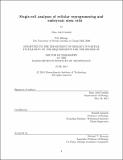Single-cell analyses of cellular reprogramming and embryonic stem cells
Author(s)
Faddah, Dina Adel
DownloadFull printable version (23.91Mb)
Other Contributors
Massachusetts Institute of Technology. Department of Biology.
Advisor
Rudolf Jaenisch.
Terms of use
Metadata
Show full item recordAbstract
Three years before the start of this thesis, Yamanaka and Takahashi published a groundbreaking paper entitled "Induced of pluripotent stem cells from mouse embryonic and adult fibroblast cultures by defined factors." A mere two scientists reprogrammed somatic cells to an embryonic stem-cell like state (termed induced pluripotent stem cells, iPSCs) by simply overexpressing four transcription factors: Oct4, Sox2, c-Myc, and Klf4. During cellular reprogramming, only a small fraction of cells become iPSCs. Previous analyses of gene expression during reprogramming were based on populations of cells, impeding single-cell level identification of reprogramming events. Using single-cell analysis, we found Esrrb, Utf1, Lin28 and Dppa2 to be predictive markers of reprogramming. We found that single cells exhibit high variation in gene expression early in reprogramming and this heterogeneity decreases are the cell reaches pluripotency. Our results show that a stochastic phase of gene activation is followed by a late hierarchical phase, initiated by activation of the Sox2 locus, leading to the activation of the pluripotency circuitry. Finally, we reprogram cells without Oct4, Klf4, Sox2, c-Myc, and Nanog. Embryonic stem cells (ESCs) are the gold standard comparison for iPSCs. Our investigation of ESCs must continue in parallel to that of iPSCs since we cannot truly understand iPSCs if we do not understand the molecular mechanisms that regulate ESC pluripotency. The homeodomain transcription factor Nanog is a central part of the core pluripotency transcriptional network and plays a critical role in ESC self-renewal. Several reports have suggested that Nanog expression is allelically regulated and that transient downregulation of Nanog in a subset of pluripotent cells predisposes them toward differentiation. Using single-cell gene expression analyses combined with different reporters for the two alleles of Nanog, we show that Nanog is biallelically expressed in ESCs independently of culture condition. We also show that the overall variation in endogenous Nanog expression in ESCs is very similar to that of several other pluripotency markers. Our analysis suggests that reporter-based studies of gene expression in pluripotent cells can be significantly influenced by the gene-targeting strategy and genetic background employed. Our results show that single-cell analysis is essential for deciphering the mechanisms of reprogramming and understanding gene regulation of ESCs, exposing important rarities typically masked by population-based assays.
Description
Thesis: Ph. D., Massachusetts Institute of Technology, Department of Biology, 2014. Vita. Cataloged from student-submitted PDF version of thesis. Includes bibliographical references.
Date issued
2014Department
Massachusetts Institute of Technology. Department of BiologyPublisher
Massachusetts Institute of Technology
Keywords
Biology.